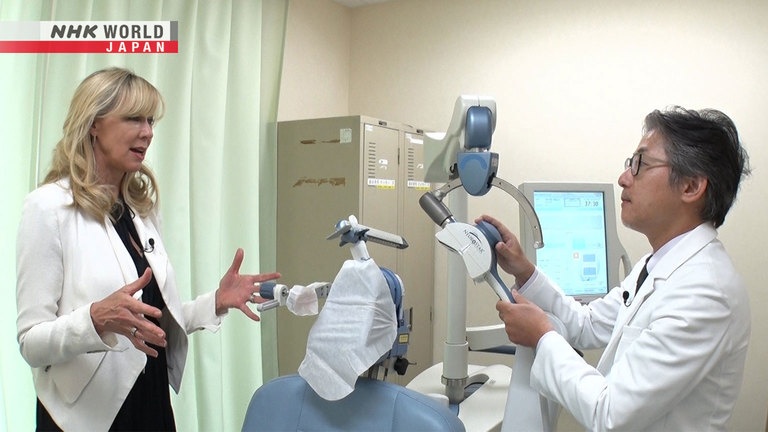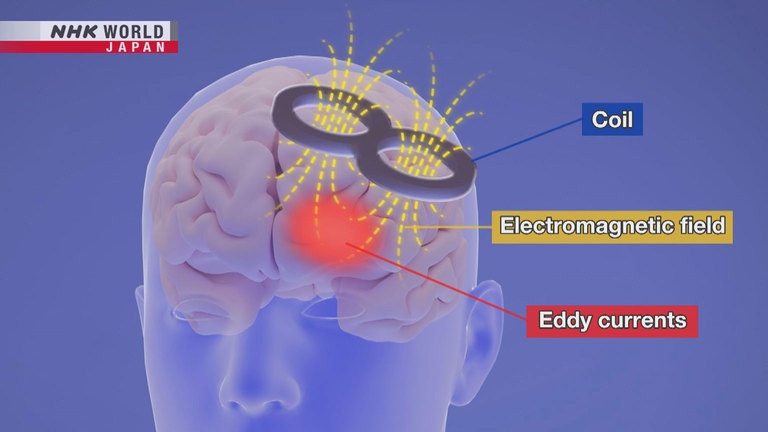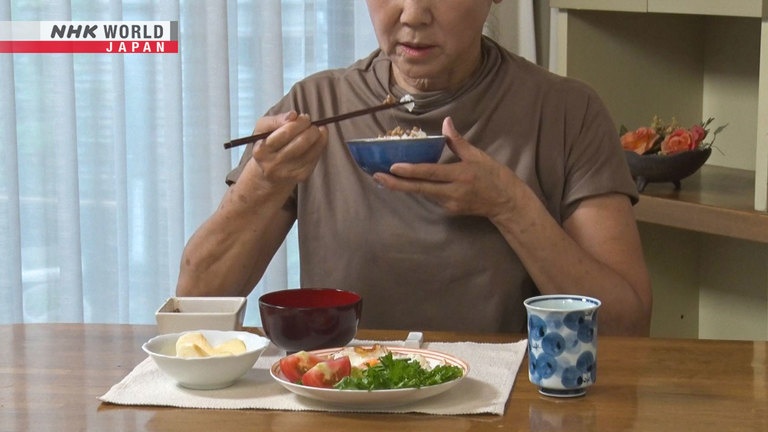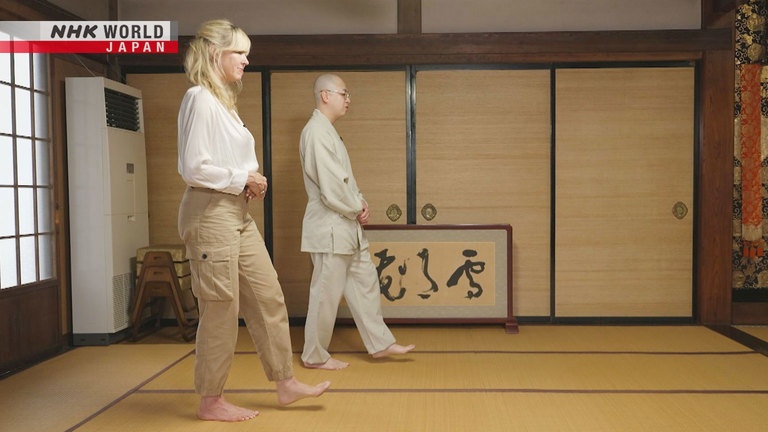Challenges in Preventing Depression Relapse
A depression treatment called rTMS, which uses magnetic fields to stimulate the brain, is showing promise. When it was administered to patients who didn't respond to antidepressants, about half showed improvement. Research is underway on its potential to prevent the recurrence of depression. Additionally, the link between depression, obesity and lifestyle-related diseases is becoming clearer. We show a case in which introducing nutritional guidance has led to symptom relief.




Transcript
Join us as we explore Medical Frontiers.
The World Health Organization says that about 300 million people worldwide suffer from depression.
It's a common disorder that can affect anyone.
One significant challenge in treatment is its tendency to recur after recovery.
Today, we're going to report on the efforts of doctors in Japan
who are studying treatments aimed at preventing the recurrence of depression.
This patient is receiving a treatment called Repetitive Transcranial Magnetic Stimulation, or rTMS.
A device is securely attached to the patient's head to generate a magnetic field.
By repeatedly applying magnetic stimulation to the brain,
this procedure can help ease the symptoms of depression.
In Japan, a large-scale clinical trial is underway to examine whether rTMS therapy can prevent depression relapse.
This woman in her 40s receives outpatient rTMS treatment once a week.
After giving birth five years ago, her health declined, and she was diagnosed with depression.
I felt sluggish and didn't want to do anything.
My child was still young so I had many responsibilities, but I couldn't fulfill them.
I was always irritated and unstable.
Depression can be triggered by various factors.
Let's begin by examining what happens in the brain of a patient with depression.
In the brain, the nerve cells, or neurons, usually communicate with each other
by exchanging electrical signals to transmit information.
For effective communication, a certain amount of neurotransmitters, such as serotonin, needs to be exchanged.
However, it is believed that people with depression have lower levels of neurotransmitters,
leading to disruptions in the smooth flow of information.
This triggers various symptoms, including feelings of sadness, loss of interest,
drastic changes in body weight, and sleep abnormalities.
A combination of several symptoms leads to a diagnosis of depression.
Depression is typically treated with antidepressant medications and cognitive behavioral therapy.
However, there are challenges associated with antidepressant therapy.
A study by the US National Institute of Mental Health found
that around 37 percent of patients achieved remission with their first antidepressant.
When including patients who got better after trying a fourth type of drug, the success rate rose to 67 percent.
But for 33 percent of people, antidepressants didn't work, and they didn't see any improvement.
This woman did not benefit from antidepressants or cognitive behavioral therapy either.
After three years of taking antidepressants, I stopped seeing improvement.
I wondered if I'd have to keep taking medication for the rest of my life.
That's when she learned about the National Center of Neurology and Psychiatry in Tokyo,
one of the leading centers for rTMS.
Kito Shinsuke has been providing rTMS therapy to depression patients for 20 years.
We use this coil to stimulate
the patient's left forehead for 4 seconds.
rTMS machines contain a coil.
When electricity flows through it, it generates an electromagnetic field, inducing eddy currents.
These currents directly stimulate neurons in the brain.
rTMS is already used in stroke and spinal cord injury rehabilitation,
targeting specific parts of the brain with varying frequencies.
The brain's dorsolateral prefrontal cortex plays a significant role
when we make decisions and judgments and experience motivation and interest.
It is located near the left side of the forehead.
Research indicates that people with depression have a reduced function in this area of their brain.
Applying stimulation to this area can activate brain function.
Doctors believe that stimulation from the eddy currents
boosts the secretion and release of neurotransmitters like serotonin,
enabling smoother transmission of information and improving the symptoms of depression.
The results of rTMS treatment show that 53.3 percent of patients saw their depression symptoms decrease by half or more.
Within this group, over 43 percent achieved remission.
And are there any side effects at all with rTMS?
Some experience no pain,
while others say it's very painful.
The stimulus can induce muscle contractions
in this area, which stop when the stimulus ends.
It's very rare, but seizures can happen.
There's a 0.07% chance of occurrence.
I've been using rTMS for about 20 years,
but I've never seen a seizure happen.
Kito's research team studied how rTMS affects blood flow in the brain.
This is an image of the brain's blood flow, taken from behind.
When rTMS treatment is applied to the left side of the head,
blood flow increases to the left dorsolateral prefrontal cortex.
At the same time, there is also a rise in blood flow to the basal ganglia.
This structure deep inside the brain is believed to control aspects such as motivation and vitality.
Furthermore, a side view image shows increased blood flow in the orbitofrontal cortex.
This area of the brain is responsible for processing emotions, social interactions and decision-making.
The woman who started rTMS therapy noticed a difference after about two weeks.
I started to pay attention to the weather, thinking things like, "It's a nice day today."
Previously, I was self-absorbed, and I didn't care about the weather, if it was sunny or not.
I didn't have the mental capacity for such things.
But I started to leave my room more, and things began to change.
The woman received a combination of rTMS and antidepressants five days a week for six weeks.
This led to a major improvement in her depression symptoms,
reducing them from a moderate level to a state close to remission.
However, rTMS therapy comes with its own set of difficulties.
This graph shows the percentage of people who saw reduced symptoms after rTMS treatment.
Three months after the therapy, 66.5 percent of patients reported an improvement.
However, one year later, only 46.3 percent still felt better,
with over half of the patients experiencing a relapse or a recurrence.
Kito enlisted the help of two patients who had experienced recurrences before.
They first received six weeks of rTMS therapy then were immediately put on maintenance treatment for one year.
This graph shows changes in the depression symptoms of the two patients over time.
The vertical axis represents their depression scores, while the horizontal axis shows the passage of time.
Notably, after six weeks of rTMS treatment, both patients achieved scores below 7,
meaning that they had entered a state of remission.
During the one-year maintenance treatment, their scores remained below 7,
meaning they stayed in remission.
Even if depression improves,
there's a possibility of a relapse or a recurrence.
To prevent that, we need to develop
better maintenance treatment.
Kito is conducting a clinical trial to investigate whether ongoing rTMS treatment can prevent depression relapse.
Dr. Kito, what made you come up with the idea of performing several rounds of rTMS
rather than just one, to prevent the recurrence?
Meta-analysis can help to determine if
maintenance treatment is really effective.
Research papers on this analysis method
report that administering maintenance treatment
after acute-phase rTMS significantly
helps prevent depression from recurring.
Going forward, Kito plans to work with at least 20 facilities across Japan
to increase the number of patients undergoing rTMS treatment for one year to 300.
He will publish analysis results related to preventing depression relapse.
The woman who appeared earlier in the program is also participating in Kito's new clinical trial.
The fear of a relapse is always with me.
Feeling less tired has been the most significant improvement for me during treatment.
I feel stable and confident that I can continue while I'm receiving treatment.
What are your other goals going forward?
Apart from depression, there are many other
mental illnesses that are hard to treat.
They include bipolar disorder,
obsessive-compulsive disorder and PTSD.
I want to expand the application
of rTMS to these conditions.
Also, treatment for depression currently
takes 3 to 6 weeks, which is quite long.
To address this, maybe we can
improve the stimulation method.
This could help to shorten
the treatment period.
Thank you so much, Dr. Kito.
In Japan, research is also underway on treating depression through better eating habits.
Psychiatrist Kunugi Hiroshi has been studying depression from a nutritional standpoint for more than 15 years.
It's a common misconception that depression
patients lose weight due to a decreased appetite.
But surprisingly, obesity also
raises the risk of depression.
This is shown in growing numbers
of studies, not only in Japan but worldwide.
In 2018, Kunugi's team did an online survey of over 10,000 people
who had never had depression and 1,000 others who had a history of the illness.
The results revealed the connection between depression, obesity and lifestyle-related illnesses.
When grouped by body type, it was found that those who were overweight, with a body mass index of 30 or higher,
were 1.6 times more likely to have experienced depression.
Furthermore, when analyzing lifestyle diseases,
they found people with diabetes had nearly 1.5 times higher the likelihood of experiencing depression.
Those with hyperlipidemia were over 1.5 times more likely to have had it.
Diabetes triggers mild systemic inflammation.
When this happens, the inflammation
also spreads to the brain.
This impairs the neuronal functions,
causing depression.
You could say that depression
is also a lifestyle disease.
Based on these findings, Kunugi has introduced nutritional guidance into the treatment of depression.
He has partnered with Miyamoto Kayoko to provide nutritional advice and conduct further research.
What are some of the biggest challenges of teaching depressed patients?
With conditions like depression, which can have
stable and unstable periods,
it is said to crucial to build trust with the patient
and provide support over an extended period.
Otherwise, our guidance won't be effective.
One of the depression patients under the care of Miyamoto was a woman in her 60s.
She had a BMI of at least 30, which classified her as obese.
She also had type 2 diabetes.
Kunugi's research revealed intriguing data.
His team looked for a link between breakfast habits and depression.
They found that among people who had breakfast almost daily,
the ratio of those with a history of depression was 7.6 percentage points lower.
But for those who skipped breakfast, the ratio was 4.8 points higher.
The team also examined the frequency of snacking between meals or late at night.
They found that among regular snack eaters,
the ratio of those with a history of depression was 3.9 percentage points higher.
But for those who rarely ate snacks, the ratio was 6.6 points lower.
And what sort of a dietary advice did you give her?
She was a homemaker, so she
regularly had 3 meals a day.
The problem was her snacking habit.
She especially liked to eat pastries.
We focused on addressing that.
Miyamoto suggested three strategies.
The first was to change the quality and quantity of pastries.
The second was to eat them less often.
And the third was to stop eating them altogether.
She chose to stop eating pastries completely.
Still, she enjoys them, and there are many tasty
ones available, so I said that if she craved them,
she could have them during lunch instead of
as a snack. I suggested trying this for a month.
I told her that it was fine if she failed,
but I made one specific request.
I asked her to weigh herself at the same
time every day and keep a record of it.
Two months later, she noticed a change.
Her weight had dropped 3 kilograms.
This weight loss motivated her to make further improvements to her snacking habits.
She loves ice cream, but Miyamoto suggested that she freeze fruits such as bananas and grapes and have them instead.
The patient continued to lose weight.
After one year, she lost a total of 12 kilograms.
Her diabetes also improved significantly.
Her level of hemoglobin A1c, an indicator of the disease, fell from 6.7 to 5.6.
And what changes have you seen in her depressive symptoms?
At first, her face lacked emotion,
but that changed quite a bit over time.
Toward the end of her treatment, she was
more cheerful and talkative, and would
share pleasant aspects of her life without
any prompting, which was a huge change.
Two years after beginning dietary guidance, her depression went into remission.
What attention or what do you pay attention to
when you're giving dietary advice or guidance to patients who are depressed?
I always try to make suggestions
that won't cause stress to the patients.
Stress can have a negative
impact on their depression.
Therefore, I try to make sure
my dietary advice isn't burdensome.
My primary concern is to minimize
any potential stress on the patients.
Kunugi's team also discovered the importance of nutrients such as folate and iron.
Further studies are underway on treating depression through dietary improvements.
Depression is evolving from a disorder that was incredibly challenging to treat
into one that can be effectively treated and overcome.
Continued rounds of rTMS provide an incredibly promising avenue of treatment,
and it offers great hope for the future in the fight against depression.
Today, we will explore mindfulness techniques to help us focus on the present moment and rest our minds.
Zen priest and psychiatrist Kawano Taishu proposes "lazy meditation,"
a simple daily practice, as an alternative to the traditional seated meditation.
Thank you for your time, Dr. Kawano.
So what are we going to learn today?
I'd like you to try mindful walking.
It involves meditating as you walk.
Many people walk with a destination in mind.
They're usually lost in their thoughts.
Instead, focus on the sensation in your feet as
you walk a familiar path. You'll notice
scenery, feel the wind and hear the sounds
of birds and insects. Your senses will open up.
Let's start with the basics.
Fold your hands in front or behind you.
Lift your heels, raise your toes, then move your foot, and put it on the floor.
Feel these four sensations as you walk slowly.
Keep your eyes on the floor about 3 to 4 meters ahead.
As you walk slowly, focus on the sensations in the soles of your feet.
This will clear your mind of distractions and allow your brain to relax.
Now, let's try it together.
Walk slowly, feeling your heel rise, your toes
lift, and your foot move forward and land.
Do the same with your other foot.
As you walk, focus only on
the sensations in the soles of your feet.
If random thoughts come up,
just bring your attention back to your feet.
After a few meters, pause and take a deep
breath. Inhale deeply and exhale slowly.
Then turn around and walk very slowly
in the opposite direction.
Because this is different from the way you usually walk,
it might feel unusual at first.
But many people gradually find the sensation
of this slow walking comforting.
I was focused on the movement rather than feeling I think.
So I think my head was stuck in, "make sure you do it properly."
So I wasn't getting into the feeling of feeling my foot on the floor yet,
but I think that's just a natural reaction.
Do this daily, even for just 3 to 5 minutes,
and it will gradually start to feel natural.
Your awareness will increase and
your focus will shift to your sensations.
Next, let's try walking outside.
This time, focus on your breathing while walking at a normal pace.
Start by inhaling for four steps, then exhaling for four steps.
Feel free to adjust this to a pace that allows you to breathe comfortably.
Much easier for me to do this one than the other one.
Really? I wonder why.
I think the other one I was so slow and focused on each specific movement
and this was, I think, it for me personally, it's a rhythmical movement
and making sure my breath was keeping up with each step.
It was far easier for me to do.
The meditation method that suits
each person is different.
The key to lazy meditation is to find
the method that's most comfortable for you.
After walking, it's time for tea.
Even while having tea and snacks, you can practice mindfulness.
First, observe it closely. Use your eyes. Then,
bring it close to your nose and smell the aroma.
Smells great.
Close your eyes and put it in your mouth.
Don't chew. Let it melt on your tongue.
Savor its sweetness and the chocolate
aroma wafting through your nose.
Now, you can start chewing it slowly.
Pay attention to each bite
and feel the sensations.
When you've fully savored it, swallow it slowly.
As you do, feel the chocolate traveling
down your throat and into your stomach.
- How was it?
- So different to how...
I would normally eat chocolate. You're so aware of even the different sensations of the tongue
where there's sweetness, where there's a little bit of more bitterness,
even how different the tongue is in terms of taste and where it feels sweeter and
the sensation and then the smell, the fragrance,
the aroma of the chocolate, which goes up to the nose.
You're getting so much more pleasure than just eating in a style that's not mindful,
you get a lot more pleasure this way.
Practice mindfulness in any form,
even lazily, on a daily basis.
Continuing it will make
your life richer and healthier.